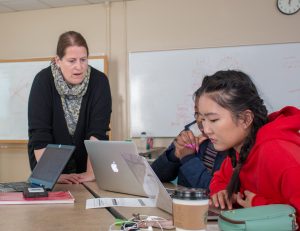About Integrated Curricula
![]()
The Integrated Curricula program is designed to incentivize and facilitate innovative co-teaching opportunities that combine quantitative natural and/or social science with the arts and/or humanities. Lead by two professors from disparate disciplines, the classroom is transformed into a laboratory for creative, complex, dynamic, and experimental thought. These extraordinary courses help prepare students to think differently and critically about their world, see things from multiple perspectives, and draw connections between seemingly distinct but fundamentally interrelated fields. While focusing on a particular topic, each course also interrogates the function (and limitations) of disciplinary divisions and the benefits of employing diverse methods of inquiry. Examples of currently-funded courses include:
 “How Do We See?” (McNeil, Physics/Astronomy; Cao, Art History)
“How Do We See?” (McNeil, Physics/Astronomy; Cao, Art History)- “Framing Public Policy: Power and Place” (Jack, English/Comp Lit; Nguyen, City and Regional Planning)
- “Visualizing Women’s Lives and Experiences” (Bardone-Cone, Psychology; Gruffat, Art)
- “Time and the Medieval Cosmos” (Clemens, Physics; Whalen, History)
- “Narrating Climate Change: Making the Global Personal” (Kim, English/Comp Lit; Wise, Geography)
- “Methods of Detection: Understanding the Process of Discovery through Detective Fiction and Behavioral Neuroscience” (Robinson, American Studies; Penner, Psychology/Neuroscience)
- “Researching Religion in Women’s Lives” (Leve, Religious Studies; Pearce, Sociology)
- “Contemporary Social Problems in Short Stories, the Social Sciences and the Press” (Bovens, Philosophy; Lithgow, English/Comp Lit)
See our course listings to review all Integrated Curricula classes.
Course development grants are available to faculty to facilitate the creation of new interdisciplinary course. To learn more, visit the Integrated Curricula Course Development page.
WHAT ARE THE ESSENTIAL CHARACTERISTICS OF AN INTEGRATED CURRICULA COURSE?
We invite proposals for interdisciplinary co-taught courses at any undergraduate level. Proposals must satisfy the following criteria:
The course should be co-taught by faculty from at least two of the College of Arts and Sciences Divisions, or one College Division and a Professional School. At least one faculty member must be from the natural or social sciences, and one must be from the arts or humanities.
The course must both focus on a particular topic and also function as an inquiry into the nature of disciplinary and interdisciplinary methods. The latter should be part of the conversation throughout the semester.
The course must be fully integrated—i.e., not simply divided up between the two faculty members. In what ways is the co-teaching aspect greater than the sum of its parts?
At least one of the instructors must be a full-time, tenure-track faculty member in the College of Arts and Sciences.
WANT MORE?
See the College of Arts & Sciences article on integrated first-year seminars team-taught by faculty members from different disciplines.
